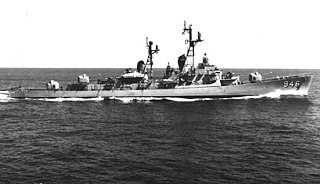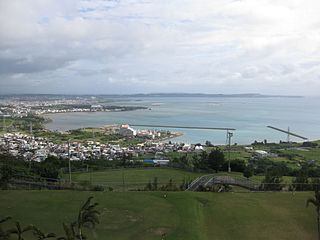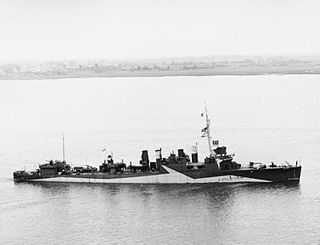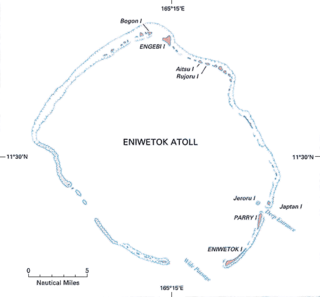The United States Navy, United States Coast Guard, and United States National Oceanic and Atmospheric Administration (NOAA) use a hull classification symbol to identify their ships by type and by individual ship within a type. The system is analogous to the pennant number system that the Royal Navy and other European and Commonwealth navies use.

The Mare Island Naval Shipyard (MINSY) was the first United States Navy base established on the Pacific Ocean. It is located 25 miles (40 km) northeast of San Francisco in Vallejo, California. The Napa River goes through the Mare Island Strait and separates the peninsula shipyard from the main portion of the city of Vallejo. MINSY made a name for itself as the premier U.S. West Coast submarine port as well as serving as the controlling force in San Francisco Bay Area shipbuilding efforts during World War II.

Bay City is a city in and the county seat of Bay County, Michigan, United States. The population was 32,661 at the 2020 census. The city is located just upriver from Saginaw Bay on the Saginaw River. It is the principal city of the Bay City metropolitan area, which is coterminous with Bay County as part of the larger Greater Tri-Cities region of Central Michigan. Several historic bridges cross the Saginaw River in Bay City, including Liberty Bridge, Veterans Memorial Bridge, Independence Bridge, and Lafayette Avenue Bridge.

USS Edson (DD-946) is a Forrest Sherman-class destroyer, formerly of the United States Navy, built by Bath Iron Works in Maine in 1958. Her home port was Long Beach, California and she initially served in the Western Pacific/Far East, operating particularly in the Taiwan Strait and off the coast of Vietnam. Her exceptionally meritorious service in 1964 in the Gulf of Tonkin was recognized with the first of three Navy Unit Commendations. During the following years she was shelled by North Vietnamese land forces, and apparently received friendly fire from the US Air Force.

Nakagusuku Bay is a bay on the southern coast of Okinawa Island on the Pacific Ocean in Japan. The bay covers 220 square kilometres (85 sq mi) and ranges between 10 metres (33 ft) to 15 metres (49 ft) deep. The bay is surrounded by the municipalities of Uruma, Kitanakagusuku, Nakagusuku, Nishihara, Yonabaru, Nanjō, all in Okinawa Prefecture. In 1852, while visiting the Ryukyu Kingdom, Commodore Matthew Perry mapped Okinawa and labeled Nakagusuku Bay as "Perry's Bay". During the final months of World War II, the bay became a U.S. Navy forward base and was nicknamed "Buckner Bay".

USS Herndon (DD-198) was a Clemson-class destroyer in the United States Navy. Herndon served in the United States Coast Guard as CG-17. She was later transferred to the Royal Navy as HMS Churchill and still later to the Soviet Navy as Deyatelny.

Manitowoc Shipbuilding Company, located in Manitowoc, Wisconsin, was a major shipbuilder for the Great Lakes. It was founded in 1902, with the purchase of the "Burger & Burger Shipyard," a predecessor to The Burger Boat Company, and made mainly steel ferries and ore haulers. During World War II, it built submarines, tank landing craft (LCTs), and self-propelled fuel barges called "YOs". Employment peaked during the military years at 7000. The shipyard closed in 1968, when Manitowoc Company bought Bay Shipbuilding Company and moved their shipbuilding operation to Sturgeon Bay.
The Defoe Shipbuilding Company was a small ship builder established in 1905 in Bay City, Michigan, United States. It ceased to operate in 1976 after failing to renew its contracts with the United States Navy. The site of the former company is now being developed for business and housing on the bank of the Saginaw River.

USS George K. MacKenzie (DD-836) was a Gearing-class destroyer of the United States Navy, named for Lieutenant Commander George K. MacKenzie (1910–1943).

USS Hanson (DD/DDR-832) was a Gearing-class destroyer of the United States Navy named after First Lieutenant Robert M. Hanson of the United States Marine Corps squadron VMF-215.

USS Yellowstone was a Shenandoah-class destroyer tender named for Yellowstone National Park, the second United States Navy vessel to bear the name.
United States ship naming conventions for the U.S. Navy were established by congressional action at least as early as 1862. Title 13, section 1531, of the U.S. Code, enacted in that year, reads, in part,
The vessels of the Navy shall be named by the Secretary of the Navy under direction of the President according to the following rule: Sailing-vessels of the first class shall be named after the States of the Union, those of the second class after the rivers, those of the third class after the principal cities and towns and those of the fourth class as the President may direct.

USS Booth (DE-170) was a Cannon-class destroyer escort built for the United States Navy during World War II. She served in the Atlantic Ocean and then the Pacific Ocean and provided escort service against submarine and air attack for Navy vessels and convoys.

USS Salinan (ATF-161) was an Achomawi-class tug built for the United States Navy during World War II. Named after the Salinan peoples, she was the only U.S. Naval vessel to bear the name.

USS Nokomis (YT-142/YTB-142/YTM-142) was a Woban-class harbor tug built in Bremerton, Wash, and assigned to Pearl Harbor, Hawaii, in 1940. Nokomis was present during the Japanese attack on Pearl Harbor, 7 December 1941. She was the first vessel on scene at the USS Arizona, and was called off by the officers on deck because of the imminent explosion of the battery below deck. It then left and helped beach the USS Nevada, with Hoga (YT-146), and YT-153. The beaching of the Nevada saved Pearl Harbor's mouth from being blocked. After that the USS Nokomis fought fires and dewatered the battleship USS California, for 3 days. This effort made the California salvageable, to be recommissioned again later in the war. Nokomis was also the last vessel to move the surviving YC-699 barge prior to the Japanese attack on Pearl Harbor. Post-war she continued serving Pearl Harbor ships until she was decommissioned in May 1973, and eventually sold for "scrap" to Crowley, in San Francisco. She was renamed Sea Serpent and served many years in the San Francisco Bay as a tug and fire boat. In 1989, after the Loma Prieta earthquake in the SF Bay area, Nokomis and Hoga fought fires alongside each other again.
Trabajador was a 111 foot (33.8 m) tug launched in 1931 from the Hong Kong and Whampoa Dock for Visayan Stevedore-Transportation Company and registered as a United States vessel in Iloilo, Philippines.

Naval Base Eniwetok was a major United States Navy base located at Enewetak Atoll in the Marshall Islands, during World War II. The base was built to support the island-hopping strategy used by allied nations fighting the Empire of Japan in the Pacific War. During 1944-5 Eniwetok was one of the busiest naval bases in the world with over 488 ships.














